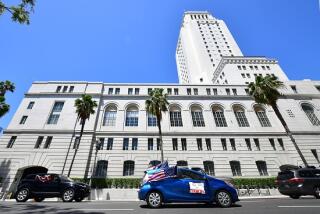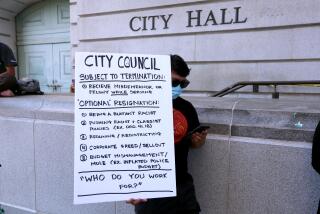Women to L.A. City Hall: Remember us?
At the dawn of this nation, Abigail Adams wrote to her husband urging that the Continental Congress “remember the ladies” as the men began to govern. Since there were no female elected leaders at the time, women had little choice but to rely on men to make their voices heard.
In Los Angeles, it wasn’t until 139 years after Adams’ letter that the first woman was elected to the City Council, but since that time many strong, independent women have served on that body.
Now, women must once again ask the city’s leaders to “remember the ladies” because, deplorably, there is not a single elected woman in Los Angeles city government.
TED RALL CARTOON: L.A.’s City Council members only care about one thing
In 1915, Estelle Lawton Lindsey became the first woman to be elected to the Los Angeles City Council. She brought a unique perspective to the table, focusing on issues the all-male council had never championed. She prioritized public health, greater services for impoverished women and the appointment of female officers to investigate crimes against women. She campaigned for better facilities for female prisoners.
Lindsey was, in short, a perfect example of how the conversation changes when women have a seat at the table, though she often found herself, as she once wrote, “on the firing line for the woman’s cause.”
It wasn’t until 1953 that another woman was elected to serve on the council: Roz Wyman. Many other women have followed in her footsteps since, and in the 1990s, there was a period in which five women served on the City Council at the same time. Women still held only one-third of the seats, but in comparison to today, that seems like a victory. The last non-incumbent woman to be elected to the council was more than a decade ago, in 2001.
On July 23, this will change when voters in Council District 6 will choose between two women in a runoff election to fill the seat vacated by Tony Cardenas when he was elected to Congress. But one woman among 14 men hardly feels like a representative government, and many committees, where policy priorities are set, will still be uniformly male.
Voting decisions shouldn’t be made simply on the basis of gender, but as we have seen again and again since Lindsey took office in 1915, the perspectives women bring to the table are unique and critically important to the future of a city made up of 54% women and girls.
Until things change, it will be more crucial than ever that each elected official remember his responsibility to represent 100% of the people in his district. With no women on the council, it is critical that the men ensure that the voices of women and girls are heard.
Council members need to prioritize issues that disproportionately affect women, including pay parity, human trafficking, domestic violence and sexual assault. It’s important that they consider, even when debating seemingly neutral policies, how their actions will affect women, and that they collaborate with the women of their districts. They need to make a conscious effort to build diverse staffs where women are equally represented. Perhaps most important, they need to recruit, mentor and support women to replace them when their terms are up, so that in years to come, women will have more secure seats at the table.
Abigail Adams went on to write, “If particular care and attention is not paid to the ladies, we are determined to foment a rebellion, and will not hold ourselves bound by any laws in which we have no voice or representation.”
We aren’t calling for open rebellion or lawlessness. However, we do remind the men of the City Council that the women of Los Angeles are watching — and unlike in 1776, now we vote.
Lindsay Bubar is director of political action and former president of the National Women’s Political Caucus Los Angeles Westside. Sandra Fluke is a Los Angeles-based attorney working on social justice issues.
More to Read
A cure for the common opinion
Get thought-provoking perspectives with our weekly newsletter.
You may occasionally receive promotional content from the Los Angeles Times.






